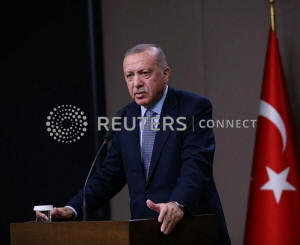Turkey will resume Syria assault if U.S. promises not met: Erdogan
 Send a link to a friend
Send a link to a friend
 [October 22, 2019]
By Tuvan Gumrukcu and Tom Balmforth [October 22, 2019]
By Tuvan Gumrukcu and Tom Balmforth
ANKARA/MOSCOW (Reuters) - Hundreds of
Kurdish forces remain near to Syria's northeast border despite a
U.S.-brokered truce demanding their withdrawal and Turkey could resume
its offensive in the area when the ceasefire expires, Turkish President
Tayyip Erdogan said.
The five-day truce in Turkey's cross-border offensive to allow the
withdrawal of Kurdish YPG fighters from the border area ends at 10 pm
(1900 GMT) on Tuesday.
Turkey says Kurdish YPG militia forces, which it views as terrorists
because of their links to Kurdish militants waging an insurgency in
southeast Turkey, must leave a "safe zone" it wants to establish inside
Syria.
"The withdrawal is continuing," Erdogan told reporters at Ankara airport
before flying to Russia for talks with President Vladimir Putin on
Syria.
"According to the information I have received from my defense minister
we are talking about 700-800 already withdrawn and the rest, around
1,200-1,300, are continuing to withdraw. It has been said that they will
withdraw," Erdogan said. "All will have to get out, the process will not
end before they are out."

Turkey began its cross-border operation nearly two weeks ago following
U.S. President Donald Trump's decision to withdraw American troops from
northern Syria.
The American withdrawal from Syria has been criticized by U.S.
lawmakers, including some of Trump's fellow Republicans, as a betrayal
of Kurdish allies who have helped the United States fight Islamic State
in Syria.
Trump said on Monday it appeared that the five-day pause was holding
despite skirmishes, and that it could possibly go beyond Tuesday's
expiry, but Erdogan said the fighting may resume.
"If the promises given to us by America are not kept, we will continue
our operation from where it left off, this time with a much bigger
determination," he said.
"SAFE ZONE"
Turkey says it wants to set up a "safe zone" along 440 km (275 miles) of
border with northeast Syria, but its assault so far has focused on two
border towns in the center of that strip, Ras al Ain and Tel Abyad,
about 120 km apart.
A Turkish security source said the YPG was initially pulling back from
the 120 km border strip. He said Erdogan and Putin would discuss a wider
withdrawal from the rest of the border in their talks on Tuesday in the
Russian Black Sea resort of Sochi.
Syrian and Russian forces have already entered two border cities, Manbij
and Kobani, which lie within Turkey's planned "safe zone" but to the
west of Turkey's military operations.

Erdogan has said he could accept the presence of Syrian troops in those
areas, as long as the YPG are pushed out.
[to top of second column]
|

Turkish President Tayyip Erdogan talks during a news conference at
Esenboga International Airport in Ankara, Turkey, October 22, 2019.
Murat Kula/Presidential Press Office/Handout via REUTERS

"My hope is that God willing we will achieve the agreement we
desire," he said before leaving for Sochi.
The Kremlin said it hoped Erdogan would be able to provide Putin
with more information about Ankara's plans for northeast Syria, and
was also studying what it described as a new idea from Germany for
an internationally controlled security zone in northern Syria
involving Turkey and Russia.
German Defense Minister Annegret Kramp-Karrenbauer said the step
should stabilize the region so that civilians could rebuild and
refugees could return on a voluntary basis.
Russia is a close ally of Syrian President Bashar al-Assad. Turkey
has backed rebels seeking to oust Assad during Syria's more than
eight-year-long civil war but has dropped its once-frequent calls
for Assad to quit.
Turkey is holding covert contacts with Syria's government, partly
via Russia, to avert direct conflict in northeast Syria, Turkish
officials say.
Some 300,000 people have been displaced by Turkey's offensive and
120 civilians have been killed, according to the Syrian Observatory
for Human Rights, a UK-based war monitor. It said on Sunday 259
fighters with the Kurdish-led forces had been killed, and 196
Turkey-backed Syrian rebels. Turkey says 765 terrorists but no
civilians have been killed in its offensive.
The U.S. withdrawal has left a vacuum into which Turkish forces have
pressed in from the north, while from the southwest Russian-backed
Syrian troops have swept back into territory they were driven from
years ago.

On Monday, U.S. Defense Secretary Mark Esper said the Pentagon was
considering keeping some U.S. troops near oilfields in northeastern
Syria alongside Kurdish-led Syrian Democratic Forces (SDF) to help
deny oil to Islamic State militants.
There was confusion on Tuesday over the status of nearly 1,000
troops pulling out of Syria into neighboring Iraq. The Pentagon had
said they were expected to move to western Iraq to continue the
campaign against Islamic State, but the Iraqi military said they had
no permission to stay in Iraq.
(Additional reporting by Ali Kucukgocmen and Ezgi Erkoyun in
Istanbul, Ahmed Rashid in Baghdad and Andrei Kuzmin in Moscow;
Writing by Dominic Evans; Editing by Gareth Jones)
[© 2019 Thomson Reuters. All rights
reserved.]
Copyright 2019 Reuters. All rights reserved. This material may not be published,
broadcast, rewritten or redistributed.
Thompson Reuters is solely responsible for this content. |